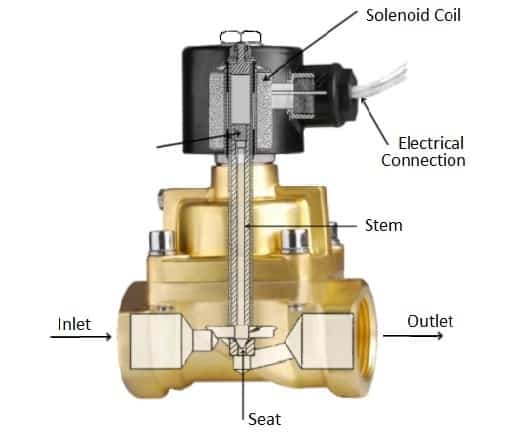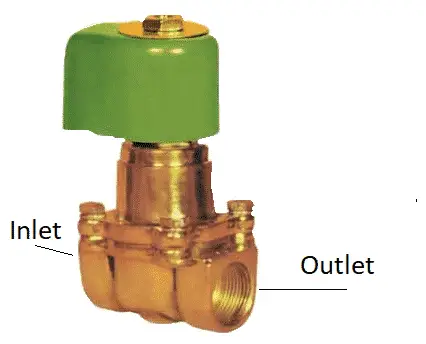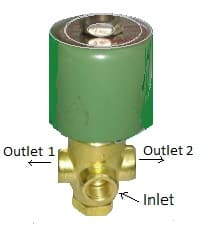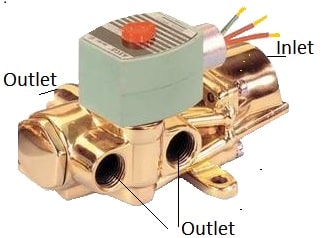Types of solenoid valves are 2-way, 3-way, 4-way, direct-acting & Pilot operated valves. In this post, we will discuss the types of solenoid valves in detail.
What is Solenoid Valve?
Solenoid valves convert electrical energy to mechanical energy. The solenoid activates when an electrical current passes through the solenoid valve coil. Upon activation of the solenoid valve, it controls the liquid or airflow through it.
Firstly, let us understand the operating principle of the solenoid valve.
Operating Principle
Solenoid valves have combinations of two different parts. One is the valve body and the other is a solenoid that is located inside the electrical coil. That is, the term “solenoid” does not refer to the valve itself, but rather to the coil mounted on the valve unit.
On the energization of the solenoid valve coil, the solenoid creates a strong magnetic force. The solenoid coil attracts a magnetic steel plunger that is located in the center of the coil.

This lower part of the plunger has its attachment to the stem of the valve body. The stem closes or opens the passage for flow control. This stem has a sealing surface called a “seat” which is what allows secure closure. Under these operating mechanics, based on magnetism, it is that all solenoid valves operate.
Types of Solenoid Valves
There is a wide variety of types of solenoid valves. We can categorize the solenoid valves according to their application, construction, and shape. There is no accord among valve manufacturers to differentiate the valve types according to their importance.
The most recent general practice is to divide valves first according to their Applications. The flow capacity of the valve for a particular application.
Application:
Based on the applications, solenoid valves have two categories.
1) Direct-acting
2) Pilot operated.
Construction:
Based on the construction, solenoid valves have three categories.
1) Normally closed,
2) Normally open and
3) Multiple actions
Shape:
By their shape, there are three types of solenoid valves in common use:
1) Two-way,
2) Three-way, and
3) Four-way or reversible.
The solenoid valves may be of combinations of the types mentioned above. For example, there are normally open and normally closed pilot-operated valves.
Now, we will discuss the details of each type of valve and its applications.
1) Two-way Solenoid Valve

The two-way valve is the most common type of solenoid valve. It has an inlet and an outlet connection and controls the flow of fluid in a single line. It can be direct acting or pilot operated, depending on the capacity of the system. Each type of these solenoids is “Normally Closed (NC)” or “Normally Open (NO)”.
2) Three-way Solenoid Valve

Three-way valves have an inlet connection that is common to two different outlet connections, like the one shown in the above figure. Three-way valves are basically a combination of the normally closed two-way valve and the normally open two-way valve, in a single body and with a single coil.
3) Four-way Solenoid Valve

Four-way solenoid valves like the one shown in the above figure are commonly known as reversible valves. Its use is almost exclusively in heat pumps. This is to select either the cooling or heating cycle, depending on the requirement.
These valves have three outlets and one common inlet. A heat pump is a central air conditioning unit with a reversible cycle.
Direct-acting Valves
We use direct-acting solenoid valves for low capacity and small ports. The plunger has mechanically connected to the valve needle. When energizing the coil, the plunger rises towards the center of the coil that lifts the needle.
The valve operation depends entirely on ;
- The power of the solenoid,
- Differential pressure
- Port Size
This valve is not suitable for large capacity systems because a large coil needs for counteracting the large differential pressure. Thus, the required coil would be large, expensive, and not feasible for very large-capacity flow.
Regardless of the pressure in the line, this type of valve operates from a differential pressure of zero, up to its Maximum Opening Pressure Differential (MOPD). pressure drop requires across the valve for keeping the solenoid valve open.
The following forces act on a solenoid valve to keep it closed or open and flowing.
When the solenoid valve is closed:
- Internal pressure pushes down into the bore.
- Gravity pulls the plunger down into the hole. In some valves, the pressure of the spring also helps to keep them closed.
- The difference between high pressure at the inlet and low pressure at the outlet keeps the plunger above the orifice.
Note: The larger the pressure differential between inlet and outlet, the more difficult it is to open the valve.
When the solenoid is opened:
1. Internal flow through the orifice helps keep the plunger open.
2. Magnetic attraction holds the plunger up.
Pilot-Operated Valves:
Pilot-operated solenoid valves use together with the solenoid coil and line pressure. In these valves, the plunger has its attachment with a needle stem that covers a pilot hole in place of the main port. Line pressure keeps a floating or independent piston closed against the main port, although, it may be a diaphragm in some valves.
There are TWO basic types of pilot-operated valves:
- Floating Piston
- Floating Diaphragm
Pilot-operated solenoid valves require a minimum opening pressure differential between inlet and outlet (approximately 0.5 psi or more) to open the main port and keep the piston or diaphragm in the open position.
Helpfull to beginners